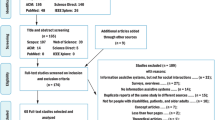Abstract
To date there are many solutions in the field of assistive technologies addressing different kinds of disabilities. Each solution has opted for very specific (and incompatible) hardware and software technologies. Recently, new devices initially destined to electronic entertainment are appearing. They have joined in a single sensor various types of technologies typical for assistance. In this paper, we show and evaluate how RGB-D sensors are capable of replacing traditional heterogeneous technologies and a single device covers several products in the field of multimodal human-computer interaction and assistive technologies. Furthermore, a prototype of a software equivalent to a traditional assistive technology product is shown.
Access this chapter
Tax calculation will be finalised at checkout
Purchases are for personal use only
Preview
Unable to display preview. Download preview PDF.
Similar content being viewed by others
References
Arumugam, D., Purushothaman, S.: Emotion classification using facial expression. International Journal of Advanced Computer Science and Applications 2(7), 92–98 (2011)
Brooke, J.: SUS: a “quick and dirty” usability scale. Usability Evaluation in Industry. Taylor & Francis (1986)
Carneiro, D., Castillo, J.C., Novais, P., Fernández-Caballero, A.: Multimodal behavioural analysis for non-invasive stress detection. Expert Systems with Applications 39(18), 13376–13389 (2012)
Castillo, J.C., Carneiro, D., Serrano-Cuerda, J., Novais, P., Fernández-Caballero, A., Neves, J.: A multi-modal approach for activity classification and fall detection. International Journal of Systems Science (in press, 2013)
Chang, Y.J., Chen, S.F., Chuang, A.F.: A gesture recognition system to transition autonomously through vocational tasks for individuals with cognitive impairments. Research in Developmental Disabilities 32(6), 2064–2068 (2011)
Costa, A., Castillo, J.C., Novais, P., Fernández-Caballero, A., Simoes, R.: Sensor-driven agenda for intelligent home care of the elderly. Expert Systems with Applications 39(15), 12192–12204 (2012)
Doukas, C., Metsis, V., Becker, E., Le, Z., Makedon, F., Maglogiannis, I.: Digital cities of the future: extending home assistive technologies for the elderly and the disabled. Telematics and Informatics 28(3), 176–190 (2011)
enPathia - Eneso - Tecnología para personas con discapacidad, http://www.eneso.es/producto/enpathia
Fernández-Caballero, A., Castillo, J.C., Rodríguez-Sánchez, J.M.: Human activity monitoring by local and global finite state machines. Expert Systems with Applications 39(8), 6982–6993 (2012)
Harada, S., Wobbrock, J.O., Landay, J.A.: Voicedraw: a hands-free voice-driven drawing application for people with motor impairments. In: Ninth Annual ACM Conference on Assistive Technologies 2007, pp. 27–34 (2007)
Henry, P., Krainin, M., Herbst, E., Ren, X., Fox, D.: RGB-D mapping: using Kinect-style depth cameras for dense 3D modeling of indoor environments. The International Journal of Robotics Research 31(5), 647–663 (2012)
Hernández-López, J.J., Quintanilla-Olvera, A.L., López-Ramírez, J.L., Rangel-Butanda, F.J., Ibarra-Manzano, M.A., Almanza-Ojeda, D.L.: Detecting objects using color and depth segmentation with Kinect sensor. Procedia Technology 3, 196–204 (2012)
ISO/IEC 25062: Software engineering – Software product Quality Requirements and Evaluation (SQuaRE) – Common Industry Format (CIF) for usability test reports (2006)
López-Jaquero, V., Montero, F., Molina, J.P., González, P., Fernández-Caballero, A.: A seamless development process of adaptive user interfaces explicitly based on usability properties. In: Feige, U., Roth, J. (eds.) EHCI-DSVIS 2004. LNCS, vol. 3425, pp. 289–291. Springer, Heidelberg (2005)
López-Jaquero, V., Montero, F., Molina, J.P., Fernández-Caballero, A., González, P.: Model-based design of adaptive user interfaces through connectors. In: Jorge, J.A., Jardim Nunes, N., Falcão e Cunha, J. (eds.) DSV-IS 2003. LNCS, vol. 2844, pp. 245–257. Springer, Heidelberg (2003)
Microsoft Corporation: Microsoft Kinect for Windows SDK - V1.0 Release notes (2012), http://www.microsoft.com/en-us/kinectforwindows/develop/release-notes.aspx
Nielsen, J.: Why You Only Need to Test with 5 Users (2000), http://www.useit.com/alertbox/20000319.html
Roccetti, M., Marfia, G., Semeraro, A.: Playing into the wild: a gesture-based interface for gaming in public spaces. Journal of Visual Communication and Image Representation 23(3), 426–440 (2012)
Schwarz, L.A., Mkhitaryan, A., Mateus, D., Navab, N.: Human skeleton tracking from depth data using geodesic distances and optical flow. Image and Vision Computing 30(3), 217–226 (2012)
Sirohey, S., Rosenfeld, A., Duric, Z.: A method of detecting and tracking irises and eyelids in video. Pattern Recognition 35(6), 1389–1401 (2002)
Sony Computer Entertainment Inc.: User-driven three-dimensional interactive gaming environment (2011), http://www.google.com/patents/US20120038637
Zhang, Q., Song, X., Shao, X., Shibasaki, R., Zhao, H.: Unsupervised skeleton extraction and motion capture from 3D deformable matching. Neurocomputing 100, 170–182 (2012)
Author information
Authors and Affiliations
Editor information
Editors and Affiliations
Rights and permissions
Copyright information
© 2013 Springer-Verlag Berlin Heidelberg
About this paper
Cite this paper
Fuentes, J.A., Oliver, M., Montero, F., Fernández-Caballero, A., Fernández, M.A. (2013). Towards Usability Evaluation of Multimodal Assistive Technologies Using RGB-D Sensors. In: Ferrández Vicente, J.M., Álvarez Sánchez, J.R., de la Paz López, F., Toledo Moreo, F.J. (eds) Natural and Artificial Computation in Engineering and Medical Applications. IWINAC 2013. Lecture Notes in Computer Science, vol 7931. Springer, Berlin, Heidelberg. https://doi.org/10.1007/978-3-642-38622-0_22
Download citation
DOI: https://doi.org/10.1007/978-3-642-38622-0_22
Publisher Name: Springer, Berlin, Heidelberg
Print ISBN: 978-3-642-38621-3
Online ISBN: 978-3-642-38622-0
eBook Packages: Computer ScienceComputer Science (R0)




